Intel IDF Keynote 2015: RealSense 'Immersion,' Wearables, Curie IoT Platform, And A Robot Spider Army
A recap of the keynote from IDF 2015: RealSense "Immersion," wearables, the Curie IoT platform — and a terrifying army of robot spiders.

Big event keynotes, especially during developer conferences, have become awe-inspiring trips into the future, intended to make you want that future to come more quickly, and for the company to show its long-term vision. Today's Intel Developer Forum (IDF) keynote in San Francisco was no exception, with Intel CEO Brian Krzanich (aka "BK") spending his time outlining the notion of immersive experiences powered by the next generation of Intel-provided technology, with a heavy emphasis on IoT and RealSense.
Because IDF, like Google I/O or Apple WWDC or Microsoft Build, is really a developer conference, this makes sense. Intel's role is to create some of the underlying platforms and hooks and, yes, vision, so that developers can build that future. Thus, most of the announcements Krzanich made were developer-focused. These included Intel Smart Sound, with "wake on voice," as well as some sound latency tweaks Intel developed for Android in conjunction with Google; some new extensions and partnerships for RealSense; and security and other enhancements around IoT.
There was a passing mention of Skylake, and some quick, staged benchmarking of 3D Xpoint, but the tastiest hardware morsels will have to come later. The vision thing, as it were, had some pretty compelling moments, built around three assumptions Krzanich and Intel are making around the future of computing: Sensification, Smart and Connected, and Extension of You. Let's put a few pieces of meat on those bones.
Intel's Take On "Immersion" Driven By RealSense
"Immersion" is a term generally reserved for virtual reality experiences, but Intel co-opted the term to describe some of its new experiences and technologies. Really, Intel just has a different take on immersion. "What is changing is that computing and the computing experience is becoming personalized," said BK from the stage. In other words, whereas the VR world sees immersion as being completely wrapped up in a virtual experience, Intel's idea is that your computing devices will surround you, weave in and out of the things you do, and, ideally, enhance your lifestyle in meaningful ways.
Intel SmartSound technology — which was "co-developed by Intel and Microsoft" and thus points to some potentially exclusive Windows 10 integration — uses an audio DSP that the OS can use to be "always listening" for your commands, even in low power states. The feature is called "Wake On Voice." In an onstage demo, an Intel rep said, "Hey Cortana, wake up," and within a few seconds, Cortana was awake and ready to work. Clean, simple, nice. The feature will be available in a wide swathe of Skylake-based chips, from Atom to the desktop Core series CPUs.
In another demo, Intel showed its reduced audio latency technology on a tablet running Android KitKat. Simply, they tapped a software keyboard on the screen to show how little latency there was. (Latency has been a nagging problem for musicians using consumer tech for years.)
A key here is that this demo was not about Android — it was about the Intel chip inside. The reduced latency tech will only be available on Intel processors, not on otherwise-powered Android tablets.
Stay on the Cutting Edge
Join the experts who read Tom's Hardware for the inside track on enthusiast PC tech news — and have for over 25 years. We'll send breaking news and in-depth reviews of CPUs, GPUs, AI, maker hardware and more straight to your inbox.

On the visuals side, Intel produced a little treat in the form of Google's Project Tango. Things have been a bit quiet on the Project Tango front of late, but there it was onstage: A prototype smartphone, "enhanced" by a RealSense camera (or several).
They used the prototype to do a quick (maybe 30-second) scan of a room that had been constructed onstage to show how Project Tango and RealSense could quickly 3D map a space. This process, we were told, is called "meshing," and Intel claimed that it's a step beyond simply 3D scanning a single object or person.
Meshing is what enables the real-time room scanning; the tech can "see through objects" and "connect" them, stitching them together to make a three-dimensional facsimile. As you can see in the images, the scan is rough (if we're being polite), although the fact that it was in color is impressive. There's also a white line showing a trace of where your phone/camera moved. We didn't get to see anything more than that, but note the tabs at the top of the screen. You can apparently adjust RGB sensitivity and color, and toggle the view, among other things.
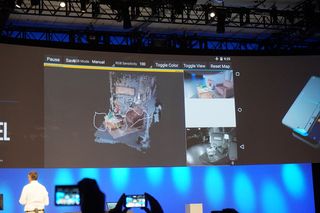
To us, this looks like a proof of concept more than anything else, and although the raw capability to do a full 3D scan on a mobile device is impressive, the images that the RealSense cameras produce are less than stellar.
This has been the case in virtually every RealSense demo or application we've seen. Intel needs to find a way to make RealSense look better, whether that's improving the cameras or the SDKs. In terms of immersion, a grainy, gritty image just won't cut it for consumers. (We'll certainly see more new RealSense demos during IDF.)
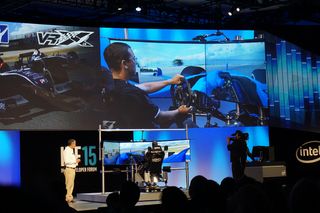
To that end, during the keynote, Intel announced Razer's RealSense-powered device that's designed for game streaming and "VR." In a demo, we saw someone sit down in a drool-worthy racing sim setup (built by iRacing and VRX), which was comprised of a chair reminiscent of a race car cockpit (that moved when appropriate), three huge displays, and surround sound. The RealSense cameras tracked his head movements so that his view from the cockpit moved with him.
In a less scintillating but still solid demo, we saw a demonstrator's avatar in a child's racing game (which involved a third-party POV). Although BK was actively waving his arms behind the presenter, the RealSense camera knew not to "see" him, focusing entirely on the person in front of the camera.
Computing Is An Extension Of You
The idea that "computing is an extension of you" can perhaps sound a bit creepy, but Intel is getting at the idea that wearables are not just things that you compute with, but devices that seamlessly integrate themselves into your life.
We saw this last year at IDF as Intel began to push out its wearables strategy, and things have progressed since then. BK stated from the stage that the wearables market has exploded in 2015, and thus the company's interest in the area is a worthwhile endeavor.
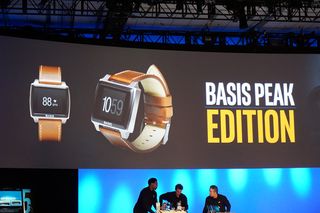
Continuing its original plan, Intel is still working closely with fashion brands to bake intelligence into items that average consumers will already want to buy — such as Fossil's Basic Peak Edition smart watch (not really a "smartwatch," but a "smart" watch), which includes a heart rate sensor and Intel's IQ software technology (which you can read about further down the page).
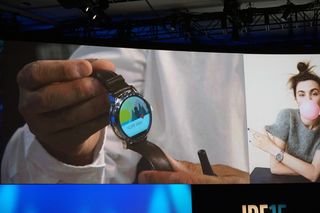
Fossil, along with other fashion brands such as Michael Kors, will be producing his and hers connected bracelets, and connected watches, as well as a watch running Android Wear. Fossil believes that these sorts of products will become "must have" items; the spending public will be the final determiner of that soon, as these products will be available at the end of October.
IoT And Curie
Intel continued its work on Curie, the company's IoT and wearables platform module, featuring the Quark SoC, Bluetooth Low Energy (BTLE), radio, sensors, DSP, and battery charging.
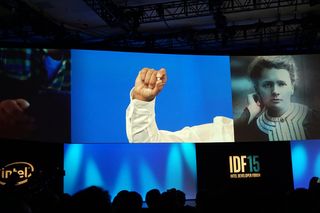
This year, Intel focused on its use in digitizing the sports world, showcasing a BMX rider with handlebars and seat Curie-enabled. (At one point, he flew off a ramp, jumping the bike over a standing BK. Live demos, indeed.)
Curie can act as a central device. It has a dedicated pattern-matching accelerator. In the bike demo, the sensors sent back data on a variety of factors, like air time, max height, bar spin, landing impact and so on. Trainers and riders can analyze this data to help improve performance. There's also an obvious application for those viewing sporting events as well. We've seen sensors employed in everything from golf clubs to basketballs and soccer balls and more, and it's clear Intel wants in on this.

Intel has already released what it calls IQ SDKs (Body IQ and Social IQ) for the body and social activities, and the company announced two new SDKs that will be released before the year ends: Time and Identity. Time IQ is for managing tasks, calendar and other planning activities. Identity IQ is for things like access control, to confirm the identity of the wearer.

BK characterized Identity IQ as enterprise-grade security at consumer-level usability.
To demonstrate an Identity IQ proof of concept, Intel had an employee wearing a bracelet using the technology. She was able to walk up to a computer system and be automatically logged in. This, BK said, could be extended to building access, system access, and even access to secure resources in the cloud.
In the demo, Intel had employed multi-level authentication. When the employee took off the bracelet, her access returned to a level where she would need to authenticate using a password; when BK put the bracelet on, it would not let him in. To re-authenticate herself, she simply donned the bracelet again, entered her password, and she was back in action.
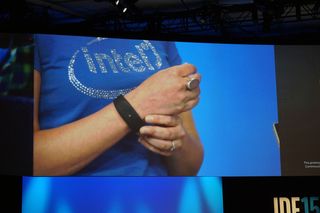
This demo created an authentication token for how and when the bracelet was authenticated. It leveraged User Authentication Service (UAS), a BTLE technology currently being standardized by the Bluetooth SIG. It will also be compatible with True Key and will allow authentication into its password vault and cloud services.
More on Curie will come at the Maker Faire in Rome, but the platform, with hardware will be available to select OEMs and ODMs in Q4. (It's worth noting, though, that Curie is not yet authorized by the FCC. The approval is no doubt pending, though.)
The Horror
In a classic "one more thing" moment to close out the IDF 2015 keynote, BK demonstrated his control over an army of robot spiders.
If you just heard Marlon Brando's voice in Apocalypse Now whisper "The horror" in the back of your mind, then your reaction to the preceding sentence is precisely the one we had witnessing it in person.
The stage staff rolled out a table full of robot spiders — more than a dozen white ones, and a large black one in the center. BK donned a wrist controller, and with a gesture, woke up the lot of them. "My spiders are all quiet," he said gently but ominously, beholding the group.
He made various movements, such as pumping his fist, and they would mimic him, and he was able to command them to, for example, lay down. (It was more terrifying to behold than it is to read, we assure you. Why couldn't Intel have made something adorable to control, like an army of ladybugs, or butterflies? Why spiders?)

And then it got weird. A curtain parted, and out of a doghouse on one side of the stage stumbled a giant mother spider, an 8-legged beast larger than a mastiff with what looked like the Project Tango phone for a face. Music began to play, and a group of human dancers flanked the momma spider and her babies (and their father, BK?) as a disco ball and several more robot spiders descended from the rafters.
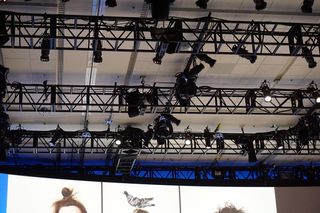
It was one of the strangest and most disorienting things I have ever seen — in stark contrast with the rest of the keynote, which showed much of Intel's upcoming technologies in the wearables space, RealSense and IoT developments, Xpoint and more.
It's unfortunate that we didn't get to hear more about SkyLake, but that's all coming soon.
Seth Colaner is the News Director at Tom's Hardware. Follow him on Twitter @SethColaner. Follow us @tomshardware, on Facebook and on Google+.
-
RamCity Nice summary of the Intel IDF Keynote Seth! It's not something I've ever been to, but you managed to keep the article short enough not to be intimidating, with enough content to be interesting.Reply -
Draven35 I can't tell, but it looks like the 'mesh' it is constructing is just a point cloud, who you'd still need to take it into other software to convert that to usable geometry.Reply
Most Popular


